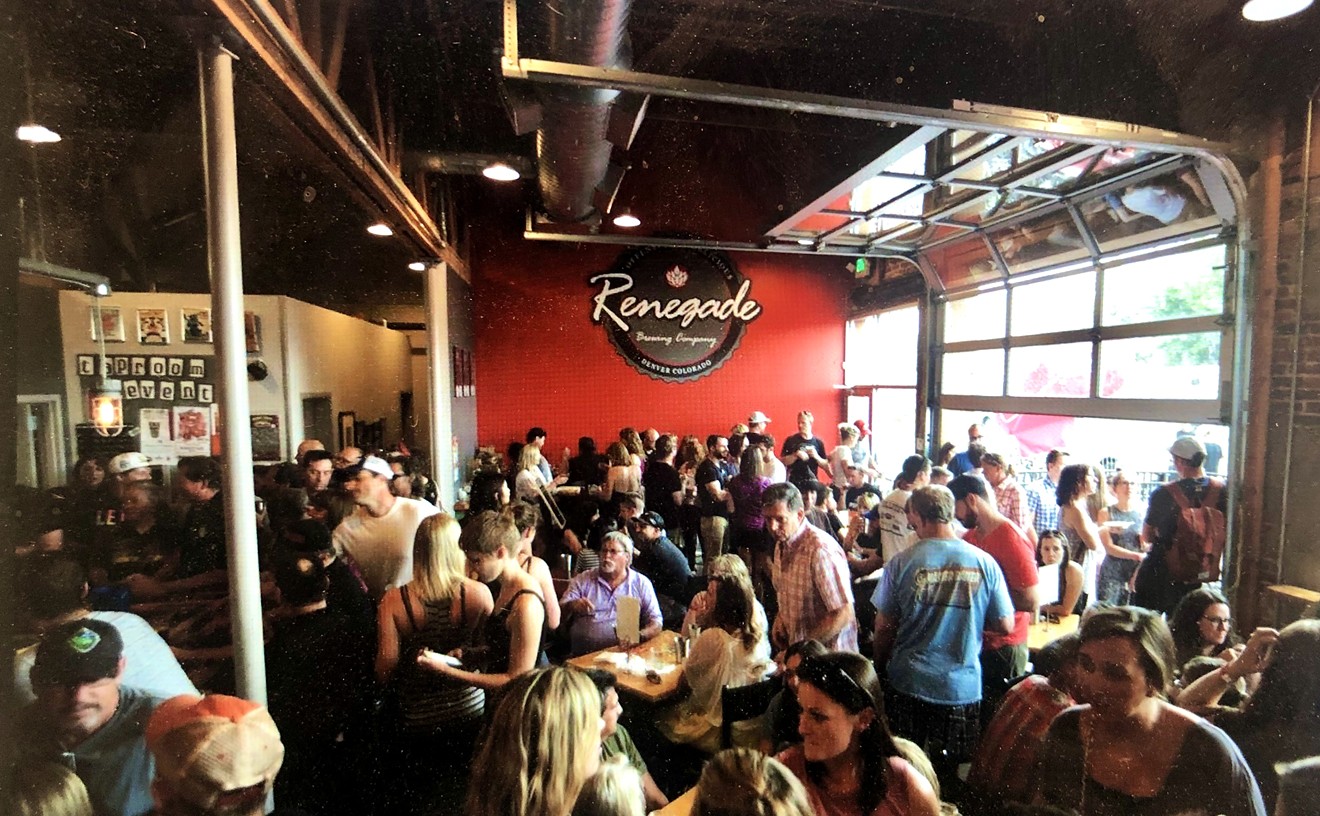But not often enough. Unfortunately, Ambrosia frequently fails to live up to its name.
Too bad, because this very austere but trendy spot sits in a neighborhood that's been desperate for decent food. Ambrosia occupies what used to be the Firefly Cafe, a longtime Denver favorite that had very much fallen out of favor over the past few years, and its concept, conceived by owners Mark Gordon and John Barocas and executed by Gordon, is a sound one. Their plan is to serve upscale, Asian-influenced fare prepared with a minimum of fuss and a maximum of flavor. But one obstacle stands in the way of Ambrosia's becoming a success: the kitchen.
The chef in that kitchen has proved himself capable of good, and sometimes great, things. In the decade since he discovered that he liked to cook more than anything else, Gordon -- who went to school in Illinois to study economics and then did a three-year stint on the volatile board of trade -- worked his way up through the ranks, starting as a deli owner with his brother in Scottsdale, then as third man down the totem pole at the highly regarded Phoenician outside Phoenix, and later in Denver as the corporate chef for the short-lived Stan's Metro Deli (don't hold that against him; the owners were weird). After that, he earned his stripes as one of the few people in town who got along in the kitchen with Santino "Sonny" Rando, first at Carmine's on Penn and then at Santino's. Most recently, Gordon opened the Italian-themed Modena in Boulder and then a second outlet in Cherry Creek North; not long after, he sold his interest in both and set out to start over with a fresher concept.
But Gordon hit a few bumps along the way. The first location he chose for Ambrosia was in the Crestmoor neighborhood, an area that opposed his application for a liquor license -- and won. (Inexplicably, the neighbors approved Michael Degenhart's application for a license at Rue Cler, which opened across the street from Gordon's original target.) "It's been an epic journey," he says, laughing about it now. "That was a tough one, and it'll still take a while to recover from it." The costs of the liquor-license fight and prep work at the Crestmoor site took a toll, and so Gordon's had to take it slow in gutting and redecorating the Firefly's old home, his backup location. The new setup may be simple, but it's appealing: The walls are the color of gourmet mustard, and one side of the oddly configured space sports a triptych of vividly colored paintings; purple and beige napkins alternate on the tables, and white lights hung around the windows and a potted plant here and there brighten up the sunken main dining area. (The smoking section of booths is in the bar.) "I have to thank the staff, all of whom are from the Firefly, who worked on the dining room day and night for two weeks," says Gordon.
He should also thank the staff for their current work in the dining room. Aside from a hitch in the table spacing -- we were bashed into repeatedly by servers trying to make their way through the tight spaces, and the table next to us actually reseated themselves in order to avoid getting whacked -- the service was not only cheerful and efficient, but the staff actually had answers to our questions and helpful suggestions about the dishes. Too bad the kitchen wasn't as efficient: The production problems we encountered at not one, not two, but three meals indicated it needs a major kick in the butt.
"I have to take responsibility for that, ultimately," Gordon says, when he hears of the snafus. "I try to keep an eye on everything that goes out, but it's hard. I know that's no excuse, though, and so all I can do is promise to keep working on it."
And the food's worth the effort, since all of the basic components are there -- and then some. The roasted corn and cilantro side that came with the batter-fried soft-shell crab ($10) was an inspired touch, adding a welcome sweetness. But we wanted much more of the corn than the tablespoon on our plate -- it looked more like a garnish than an actual part of the dish. And the batter on the crab was much too thick, which made it hard to get a handle on the crustacean, much less a good taste of its meat. Our other starters worked well, however. An order of beef tenderloin done satay-style ($8) brought three skewers of tender, thinly sliced beef, along with a thick, gooey, sweet-and-spicy peanut sauce; the sweetly seasoned Vietnamese spring rolls ($6) were crunchy-skinned on the outside and filled with good-quality shrimp inside.
Although the menu's description of the buffalo mozzarella and tomato salad ($7) was misleading -- it read "house-made," which implied that Ambrosia makes the cheese, which it doesn't -- there was no mistaking the mozzarella's fabulous flavor. It may not have been "house-made," but it was certainly authentic: In Italy, real mozzarella is made from the milk of a water buffalo; the rubbery stuff we usually get in this country is fior di latte, made from cow's milk. This cheese was stunning: creamy and rich and slightly sweet, especially when layered with fresh, red-ripe tomato slices that had been soaked in a sweetened balsamic vinaigrette. Sadly, there was also no mistaking the brown-edged, soggy iceberg lettuce in a retro salad with blue-cheese dressing ($8); to carry off this minimalist creation, the iceberg must be impeccably crisp. But at least the dressing was rich and tangy, the cheese almost indistinguishable from that current benchmark of domestic blues, the estimable Maytag.
By the time our entrees arrived, the production discrepancies were making us dizzy. The salmon Napoleon ($18) was impeccably grilled, but it hardly tasted of the maple-soy glaze promised on the menu; while the candied pecans offered a nice counterpoint texture, the array of cucumber slices, ostensibly intended for the same purpose, were jarringly cold. As a result, taking a bite of this dish was sometimes like eating a salad and sometimes like eating a regular warm entree. (Gordon says he has since reworked this dish.) With the lobster and rock shrimp noodles ($18), the fatal flaw was that the noodles were really orecchiette, or "little ears," a pasta so absorbent that it soaked up what little wetness there was to the dish. According to Gordon, the Thai cream sauce is a red curry mixed with coconut milk, but we received so little, and it was so mild, that it was hard to discern any ingredient other than wild mushrooms -- which were wonderful, but not what we expected. The lobster and shrimp meat were beautifully cooked, though, and moist enough not to need any sauce, bland or otherwise.
Gordon blames the blandness on the neighborhood. "I started out with all of these spicy things," he explains. "And stuff kept getting sent back, so I had to change them to make people happy. But they're definitely not what they started out to be, and they're not what I think would be the ideal flavors for them."
He can say that again. On a return visit, our lunch entree of four-cheese ravioli with vodka cream sauce ($8) might have had the right pasta, but the dish badly needed Gordon's original sauce: What he swears had once been a cream concoction enhanced with red chile flakes and vodka now tasted like tomato-tinged cream. An interesting red-chile sauce, almost a purée, came with the salmon spring rolls ($6), but the fish smelled so rank that we abandoned the dish after two bites, along with two other sauces that crisscrossed the plate. When I later told Gordon of the funky salmon, he was mortified -- and saddened that we'd missed most of the sauces. "At first I was drizzling those across," he says. "But people thought they were too spicy or too strong."
The lamb dumplings ($7), however, still sported a feta-filled relish that was pungent and vinegar-strong. But while the lamb inside was juicy, the dumpling wrappers had been chopped off rather than twisted closed, and the stubby little ends were as hard and chewy as partially cooked pasta. Another kitchen blunder ruined the tuna melt ($9). Although the upscaling was smart -- ahi mixed with a tiny amount of celery atop a thick, crusty roll blanketed with melted Swiss cheese -- the usually succulent fish was dry and overcooked, possibly from the heat of the cheese, since Gordon says he shoots for medium-rare.
But Gordon keeps missing the target. On a third visit, his aim still wasn't true. The ribeye ($18) was a lovely piece of meat, but it arrived medium-rare rather than the medium we'd requested; the black beans in the relish side were hard and chewy. And while the grilled sea scallops ($19) came bathed in a surprisingly potent, spicy serrano-charged, orange-tangy broth, they'd been tortured into dry, stringy specimens by an overzealous grill guy. Once again, bad execution ruined a good idea.
Along with trying to correct the production problems, Gordon's also fine-tuning the Ambrosia concept, planning for lower-priced dishes that will inspire locals to come back more often.
But first, he has to make them want to come back at all. And in order to do that, Gordon must make sure everything tastes delicious.










